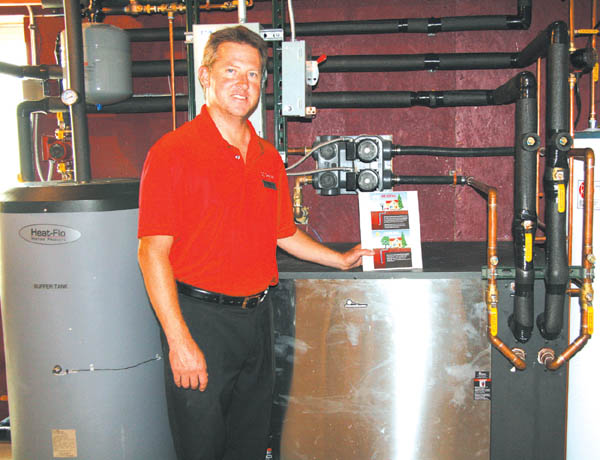 The G.J. Gardner house's family room (with furnishings by an interior decorator) at 1561 Gold Hill Mesa Drive. Westside Pioneer photo
|
That's the new “near-net-zero” four-bedroom home built by Wayne Intermill, owner of Hi-Point Home Builders and locally affiliated with the national G.J. Gardner Homes company.
Priced at $525,000, the 3,900-square-foot house is at 1561 Gold Hill Mesa Drive.
An analysis of its energy-saving amenities - which include geothermal climate control, water-usage efficiencies, a photo-voltaic solar system, radiant floor heat, even environmentally friendly paint - shows that on average a family living there would spend only about $55 a month on utilities, Intermill said.
The allure has helped the Gardner house become the most popular of the three Gold Hill Mesa residences in this year's Parade of Homes, with more than 2,331 visits since it began Aug. 5. By comparison, the J.M. Weston model has recorded 1,642 visits and the Challenger home 1,309, according to Bob Willard, lead developer for the Gold Hill Mesa project.
The Parade will continue through Aug. 21.
“It's a well-designed house,” Willard said. “We need to have them on more lots. People are loving that house and the environmental stuff.”
Intermill, who has been in the business since building his own house 16 years ago, started gravitating toward modern energy efficiencies about eight years ago when a customer asked him about installing a geo-thermal system (in which fluid piped in loops more than 300 feet below the ground uses the constant temperature of the earth toward providing heating or cooling).
 Wayne Intermill poses with some of the piping and other equipment used for the house's geothermal climate control. Westside Pioneer photo
|
The more Intermill researched, the more he got interested in the possibilities - plus, he started finding a market for such homes. “I'm not a tree-hugger,” he said. “But there are ways we can conserve what we have. We've got to give something back to Mother Earth. And this is the way of the future.”
For the Gold Hill Mesa house, Intermill decided to take his efforts a step further and try to get a Leadership in Energy and Environmental Design (LEED) certification, offered through the U.S. Green Building Council. “Those are pretty strict specifications you have to meet,” he said. Also, the water-saving technologies he built in allowed his house to meet the “pretty strict specs” of the Environmental Protection Agency's (EPA's) “Water Sense” standard.
However, Gardner noted that every significant “green” amenity a builder puts in adds to the price of a house. For example, the Gold Hill unit has received a “near zero” rating (13) from the EPA's Energy Star rating system, but to get to zero “it would be very expensive,” Intermill said. The geothermal alone represents an investment of $64,000, he pointed out.
 The Gold Hill Mesa house's Energy Star rating of 13 can be seen in comparison with scores typically received by other construction projects. Westside Pioneer photo
|
As it is, the Gardner house's $525,000 asking price is by far the highest of any Gold Hill Mesa home, Willard said, and the decision to go ahead with it represented a “big risk.” This week, though, he happily reported that there has been keen buyer interest in the Parade house, also that Intermill recently presold a similar near-net-zero house of smaller size elsewhere at Gold Hill that he has not even built yet.
In addition to the unbuilt house and the Parade house, Gardner/Intermill has a tentative agreement with Willard to build on five more lots in the 210-acre development.
Intermill said he enjoys working with Gold Hill Mesa, which is in contrast to other big developers who find customized homes an intrusion. “I'm definitely doing more here,” he said.
Westside Pioneer article